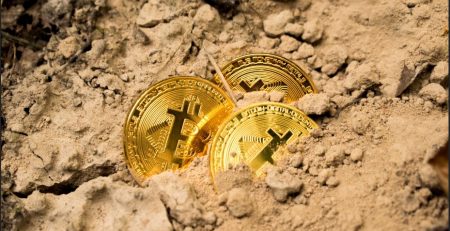What is Bitcoin? Everything you need to know about Bitcoin
It all started in 2008 with the publication of an article that introduced an electronic currency called bitcoin. The anonymous identity of Satoshi Nakamoto was the initiator of a revolution that years later became the headline of the media, forcing economists to debate it extensively.
Bitcoin is a digital currency that you can use to buy, order online, send money to anyone you want anywhere in the world, or even consider it as an investment.
With the tempting rise in the price of digital currencies, you may have heard about the king of digital currencies in the news and cyberspace, and while browsing various sites, you may come across topics such as what bitcoin is or how you can get free bitcoin.

What is Bitcoin?
Bitcoin is a kind of electronic money with which you can send money anywhere in the world or use it to buy goods and services.
The two main features of Bitcoin, decentralization and the avoidance of printing more currencies, are important gains against today’s currencies that pave the way for a new form of economic system in the future.
The two main features of Bitcoin, decentralization and the avoidance of printing more currencies, are important gains against today’s currencies that pave the way for a new form of economic system in the future.
Bitcoin can consider as an investment, by its currency transfers it to do and even online stores order.
The same different functions and different uses that you can have from Bitcoin may be the most important reason and the best answer to the question why you should be more familiar with this phenomenon.
Who controls Bitcoin?
Unlike today’s currencies, which are supplied and distributed by governments, Bitcoin is not controlled by any particular individual, group, or organization.
People who enter the network of this digital currency must accept the rules of the network.
These rules are in the form of programming codes that can be seen by everyone on the Internet.
There are various groups in the Bitcoin network, the most important of which are miners, developers and network nodes.
Each of these groups has a specific task in the network; For example, miners or miners verify the transfer of bitcoins, also called transactions, on the network. Or developers are voluntarily responsible for upgrading Bitcoin software and its capabilities.
Nodes also store the history of network transactions on their hard drives.
Bitcoin is not in fact controlled by any of these groups, governments or other specific individuals, and the cooperation of the various groups present in the Bitcoin network will keep it alive and growing. But why should there be such a complex system?
What are the problems with traditional banks and financial systems that lead us to use bitcoin?
What is the purpose of Bitcoin?
In short, the purpose of bitcoin is to securely transfer or store money. Therefore, it can be considered a secure digital payment and banking system. Bitcoin actually restores real control of the money to individuals, and with a special password called a private key, only the owners of those keys will be able to spend and transfer the bitcoins.
On the other hand, digital money has always had a big problem called “double spending”. This was not the case with paper money and physical money, for example you could not re-use the money you spent on a TV to buy another product.
But in a digital world where you can copy everything with just one click, it is important to avoid double spending. If digital money is like a file, you can spend it in two separate places at the same time and you have made your purchases so that the sellers know about it.
That is why, before the advent of digital currencies, there was always a central organization to check individuals’ inventories to prevent this from happening. But with the advent of this digital currency, the existence of a central organization was abolished and transactions were reviewed by all members of the network.
So another important goal of Bitcoin is to solve the problem of spending twice without trusting someone else.
Who made Bitcoin?
Bitcoin was born in late 2008. You probably remember the big financial crisis of 2008 and the events of that time from the news. It was around this time that an unknown individual or group, alias Satoshi Nakamoto, sent an article to a large number of cryptographers talking about new electronic money. In this article, also known as White Piper, Satoshi Nakamoto described bitcoin and how it works.
A few months later, in early 2009, the Bitcoin network began operating. Satoshi Nakamoto was in the early years of the project, fixing its shortcomings with other developers joining the project until it disappeared in late 2010.
More than 10 years after the creation of Bitcoin, the identity of Satoshi Nakamoto has not yet been determined. Satoshi Nakamoto can be an individual, a group of programmers, or even a secret government organization. There are many hypotheses about Satoshi Nakamoto’s identity, and many more claimants have identified themselves as Satoshi Nakamoto. However, none of them have enough evidence to prove their claim.
What is Bitcoin support?
Surely the question has arisen for you, what is the support of Bitcoin? In answer to this question it must be said that nothing; Bitcoin has no support! While backing can be a misnomer, the question is, what do you think is the backing of the currencies you use every day and currencies like the dollar and the euro? The answer to this question is nothing.
Bitcoin, like today’s currencies, is not backed by precious metals such as gold or commodities.
The fundamental value of bitcoin and unsupported currencies stems from the trust of people who believe they are valuable.
Just as you believe that you can give your banknotes to the shop and buy the goods you need, so does the shopkeeper know that by giving these banknotes he can buy the goods he needs, so these banknotes go hand in hand in society. be.
But on the other hand, looking at the use of bitcoin in today’s world, we can see that most people buy bitcoin to invest and not to use it in their payments. That is why there is another view that bitcoin can be used as an asset in addition to being a currency; An asset that can maintain its value over time. For example, the value of gold against basic commodities such as food and clothing has been almost constant over time. Accordingly, Bitcoin can also be considered an asset, considering the features that we will introduce in full below. But how is bitcoin valued and who determines the price of bitcoin?
How is Bitcoin valued?
The value of bitcoin is not determined by a particular individual or group. Just as the price of gold in world markets is determined by supply and demand, the price of bitcoin in exchanges and brokerages is determined by the two main factors of supply and demand. If the supply force in the market is greater than the demand, prices will move in a downward direction until demand is equal to supply again.
On the other hand, this digital currency can be considered as having a fundamental value, the amount of which is obtained according to the condition of its network and the cost that miners spend to extract a unit from it. Despite the different valuation methods, the price of Bitcoin is ultimately determined by the supply that can be generated by the extractors or the demand generated by the investors.
What distinguishes Bitcoin?

Transferring and spending bitcoins does not require permission from banks or any other entity. On the other hand, you may have heard that bitcoin is the money of criminals and is used to remain anonymous in criminal activities. But aside from the misnomer attributed to bitcoin by newspapers, news, and the media, this digital currency has features that set it apart from other physical and digital currencies. The basic and important features of Bitcoin are described below:
- No one is in power
- The number of bitcoins is limited
- Transactions are semi-anonymous
- Transactions are non-refundable
- Can not be forged
- It is easier to carry and transport than gold and physical money
What is blockchain?
Distributed storage of bitcoin transaction information is made possible by blockchain technology. Blockchain is, in simple terms, a digital notebook whose information is immutably distributed across all nodes. Blockchain is a broader concept than bitcoin that can have other uses. If we want to show this difference very simply, we can compare blockchain to the Internet and bitcoin to a famous search engine like Google.
Because of the blockchain, nodes keep transaction histories. When one of them wants to send some bitcoins to another, by sending their request in the form of a transaction, the nodes flip through their digital notebooks and obtain the sender’s inventory to ensure that the transaction is feasible. The digital notebook of nodes consists of sheets that in a blockchain are known as blocks and contain information and data. If the transaction does not violate the rules of the network, the transaction is considered valid and, like the production line of a factory, waits to enter the next stage, the transaction approval process.
Read more: What is blockchain?

How are transactions done?
Once transactions are validated by nodes, they wait in a place called Mempool to complete the verification process. To better understand how transactions work in the Bitcoin network, it is better to explain it with an example. Mempool can be assumed to be a bus station whose passengers (or transactions) are waiting for the bus to arrive (confirm) them. The bus drivers are the miners or miners who, after entering the station, fill their buses with these passengers as much as they can. Buses also play the role of blocks in the bitcoin network in this example.
Of course, we need to change this example a bit to show the real network conditions. A passenger can sit on several buses at the same time, and the physical laws of our world do not apply to him in this example! Because a transaction can also be selected by several miners and placed in the block of one of them. Passengers are now sitting on buses waiting for drivers to start moving to a final destination. This destination is actually the transaction confirmation.
With the start of a race called mining or mining, bus drivers try to get their transactions to their destination faster than others; Because the first driver who succeeds in doing so will receive a good reward from the bus company (network).
After selecting the transaction and placing it in their blocks, the miners start solving the mathematical puzzle of the block in a competition called extraction, which requires energy and processing power. This mathematical puzzle arises from putting transactions together and passing them through cryptographic processes called hash functions. Solving these puzzles is a difficult task that is done with computer hardware and special devices called miners or ISICs . Finding the answers to these math problems will eventually lead to the confirmation of the transactions in that block.
After finding the math puzzle, the block is placed next to other blocks that have already been solved, in a chronological order, and an interconnected chain of blocks is formed, which in fact represents the concept of a block of blocks or a chain of blocks.
The process of confirming a transaction by finding a mathematical puzzle is also called the Proof of Work process. But miners need an incentive to do all of this, including providing special hardware and power consumption. What motivates miners to work in the network?
Where does Bitcoin come from?
The answer to the question of who makes bitcoins is the same as what motivates miners to operate on the network. The first miner to succeed in finding the math block puzzle in the network sooner than the others will receive a reward equal to the network’s own currency, bitcoin. This reward for miners comes from two main sources:
- Fees or transaction fees specified by users.
- Block reward that is awarded to the winning miner after solving the block.
Bitcoin transactions are not free, and users have to set a certain amount as a fee to attract miners to confirm their transactions. Miners are also logically interested in choosing transactions whose fees are higher than others.
Finding the answer to the blocks will lead to the release of a number of bitcoins on the network. The approximate time for each block to be added to the network is about 10 minutes. On the other hand, after periods of about 4 years, the number of bitcoins released by miners in the network also decreases. Currently, more than 18.4 million of the 21 million bitcoins on the network have been mined.
What factors determine its price?
As mentioned, the price of bitcoin is generally determined by the supply and demand forces. But in more detail, there are a number of factors that can affect it. For example, legislation banning the extraction or sale of bitcoins in one of the economically large countries could affect its price. Development status, developer decisions, important and expected events and happenings are other factors that can affect the price of bitcoin.
Of course, the digital currency market is still volatile due to insufficient maturity and being in its infancy, and on the other hand, it sometimes experiences drastic changes with the supply or demand made by whales. Whales are big investors who have a lot of bitcoins and their activity in the market causes prices to fluctuate sharply; Just like the movement of the waves in the ocean, which create a lot of turbulence around them.
Reasons for price increases
A number of factors that we have mentioned can have a positive effect on the price of bitcoin. For example, offering more financial products, such as futures contracts and ETFs, can attract the attention of large and diverse investors. Positive legislation in this area can also benefit the price of bitcoin. On the other hand, this digital currency was born in the financial crisis of 2008, so any situation that leads to global economic instability, can draw attention to this digital currency as a tool that has the ability to store value. Economic instability can stem from civil wars, rising and uncontrollable inflation, and geopolitical issues.
If we look at the issue from a general point of view, the factors that reduce supply and increase demand can also be considered as reasons for price growth. The amount of bitcoin produced or released on the network by miners is a variable that is out of the hands of miners and others and is written in the rules of the network. The extraction rate is a fixed rate every ten minutes for a period of 4 years, however it is the entry of the extracted coins into the exchanges and the place of sale that can be considered as an effective supply.
Therefore, when the price falls below a certain amount, the cost that miners incur in acquiring bitcoin increases and its sales by miners decrease. Other reasons that can increase demand and consequently increase prices are the use of bitcoin and its increasing acceptance by businesses and people. For example, if prominent businesses such as Amazon or Apple accept it as a payment method, this could lead to a rise in the price of this digital currency.
Reasons for lower prices
In addition to the factors that can increase the price, there are other reasons and events that determine the price of bitcoin. The announcement of mining and trading bans, along with the news of the rejection of financial products such as ETFs, are among the most important factors that can affect the price of this digital currency in the short term. On the other hand, because institutional and large investors own a large part of this digital currency, the price of bitcoin has also correlated with stock markets. Therefore, when the stock market situation is uncertain and declining, the price of bitcoin is likely to fall.
Developers can also influence the network development process with their decisions. For example, if the decisions of one group of developers contradict another group, this could lead to their separation and lead to a so-called fork. Forks or separations often have a detrimental effect on the price of a digital currency in the long run.
But perhaps the most important factor in lowering prices is the fear of traders and investors, which is due to the psychological atmosphere of the market. The movement of whales and the deliberate reduction of prices by them is another reason that is done with the aim of removing small traders from the market.
Price chart
The first data on the Bitcoin price chart dates back to mid-2010, when it traded at a price close to one cent ($ 0.01). From its inception, this digital currency has witnessed several up and down price cycles. Accordingly, in certain periods of time, the price of Bitcoin has been in an upward state, which is called an ascending market, and in other periods, it has been in a downward and decreasing state, which is called a descending market.

In the first uptrend between 2010 and mid-2011, bitcoin rose from about one cent to $ 30, an increase of 3,000 times. The price of this digital currency experienced a sharp decline after this astronomical increase; From mid-2011 to late that year, it saw a 95 percent drop from $ 30 to $ 2.
The second uptrend was moving from $ 2 and growing 600-fold to $ 1,200. This upward trend started in late 2011 and continued until the end of 2013. After this sharp growth, the price fell 86 percent to about $ 165 and was trapped in the downtrend market until the end of 2015.
Bitcoin’s third uptrend began in early 2016, pushing Bitcoin to the $ 20,000 price target in December 2017. This growth almost 100 times stopped in 2018. Bitcoin is still struggling to break the previous record after more than two years of hitting its highest level.
How to buy bitcoin?

Bitcoin purchases are usually made through online exchanges or resellers. You can buy bitcoins through bank cards, credit cards or other digital currencies.
In general, the process is as follows:
- Install wallet
- Find a reputable seller (online exchange or real person)
- Deposit money to the seller account and give the wallet address to receive bitcoins (some sites have their own wallets)
- Bitcoin transfer
When you buy Bitcoin, you will be asked for authentication with documents to prevent fraud, money laundering.
Why should I buy bitcoin?
If you know someone around you who talks a lot about Bitcoin and related issues, you probably have the question, “Should I buy Bitcoin too?”
Just a look at the ever-rising chart of this digital currency in its many years of history is enough to make you think that today’s bitcoin is always more valuable than yesterday. But this is a misconception and can get you in trouble. This issue usually becomes hot among the people and the media when the price of bitcoin rises sharply. Such price increases introduce a new range of people to this phenomenon, and many of them buy at peak prices. The result of such a wave of buying, as has been seen many times, has been the experience of huge losses and the loss of large investments.
When everyone is rushing to buy bitcoin, this is exactly the time to avoid buying it.
In addition, you need to know and be familiar with what you are buying. So your decision to buy and invest is based on your belief in the future of the technology. Finally, you need to know bitcoin first, clear up your ambiguities about it, and if you believe it has the potential to become the currency of the future and achieve its goals, buy it at the right time!
Can anything be bought with it?
The use of bitcoins to buy goods and services is increasing. For example, users can now use bitcoins to buy online domains from half-chips, video games, gift cards, etc. through services such as bitcoin . Bitcoin shopping in restaurants and stores is also expanding globally.
One of the barriers to bitcoin acceptance in various businesses is the slowness of its transactions, which customers have to wait a long time to confirm. Lightning network is one of the solutions that use it to make transactions faster.
Bitcoin wallets
You do not need to open an account with a specific bank or company to store or maintain bitcoins. In this space, you are your own bank.
A wallet is a tool for storing, sending and receiving bitcoins. Users can use different types of wallets according to their conditions and needs. These include mobile wallets, desktops, web wallets, paper wallets and hardware wallets.
Mobile, desktop, web and paper wallets are free and users can easily download and install them. But hardware wallets must be purchased because they are physical.
You can see a number of wallets that support it by visiting the official Bitcoin site or selecting the wallets section on the digital currency site.
Note that transactions are non-refundable and the network is not under the control of any organization. For this reason, be sure to back up your wallet and keep the recovery words in a safe place so that you can recover your money on another device in case of any problems for the device on which the wallet is installed. Also, do not share your wallet password or private key with anyone.
Can Bitcoin be hacked?

If we want to have an accurate answer to this question, there is a way of penetration for each network. On paper, any kind of cryptography can be cracked, but it can be said that hacking the network and doubling bitcoin, depending on the extent of the network and the benefit of its miners in the correct (and not malicious) operation, will prevent this from happening. The main bitcoin network has not been hacked yet and it has never been doubled. The occurrence of this incident can somehow damage the credibility of this digital currency and cause it to depreciate.
Wallets and exchanges can be hacked, and there have been several major hacks so far, but the Bitcoin network itself has not had a serious security problem so far. This can be compared to the Internet. Hacking a website on the internet does not mean hacking the internet itself.
There are several different ways to hack a bitcoin network, the most important of which is the 51% attack. This attack requires powerful mining equipment so that more than 50% of the network processing power can be captured. Due to the vastness of the network and the high cost of a double attack, there is no incentive to do so and it can be considered almost impossible.
What is a 51% attack?

A 51% attack is a type of attack in which the attacker takes control of more than half of the network power. Because transactions in the Bitcoin network are verified by miners, controlling more than half of the power of these devices increases the likelihood that one person will approve the transactions and build the blocks .
If a particular person or group can approve most transactions, they will be able to carry out a double spending attack.
This attack is when the attacker transfers his digital currency in the form of a transaction in exchange for money, goods or services. The attacker then takes control of the transactions and builds the blocks, and starts building blocks faster than the others. One of the rules of bitcoin and digital currencies is that the longest chain with the most blocks built is known as the valid chain. If the attacker can build the chain sooner than the others and does not place his first transaction in the blocks, he will be able to execute a double spend or a 51% attack.
What will be the future of Bitcoin?
Whether Bitcoin will be used in the future as a currency that our paper money today looks ridiculous to, or as a technology that once made a fuss and was then forgotten, is a belief. People depend on bitcoin. The acceptance of this digital currency has been growing since the beginning of its history and the continuation of this path seems to be the most probable option. The use of bitcoin as a tool that is able to store value over time, along with its use as a means of payment or money is increasing, but in addition to all this, bitcoin has problems that can speed up its acceptance. Reduce and in the worst case be a barrier to its pervasiveness.
What are the problems with this currency?
One of the most important problems that Bitcoin faces is the difficulty of understanding it and presenting completely new concepts that exist in various fields of computer science, economics, game theory and several other fields. So if you are new to this field, I must say that it is a difficult but pleasant path ahead!
Bitcoin transactions are slow compared to the banking transactions and daily payments you make. The average ten minutes you have to wait for transactions to be confirmed, although it has increased system security but also reduced ease of operation. Of course, for this problem, there are solutions such as Lightning, which can be used to make instant transactions with Bitcoin.
Because Bitcoin is a new phenomenon, it has faced many legislative problems in different countries. Some countries, such as Japan, have legislated and adopted it as a currency, while others have banned its sale and use. In addition, many more countries have not yet taken a clear stance on digital currencies.
The fees and costs of bitcoin transactions are often so high that it is difficult to use them in micropayments. Of course, there is a similar solution to this issue, which is to use the Lightning network.
Can governments ban it?
Bitcoin came into being by targeting banks and financial intermediaries whose biggest backers are the government. Governments can make it difficult to use bitcoins within their own countries by interfering at various stages of its extraction or sale, but with all these cases, this phenomenon cannot be fully resisted.
Transactions that take place within the network are beyond the control of any organization or government. If the use of bitcoin becomes practical and you no longer need to convert your bitcoin into cash to make a purchase, then stopping the use of bitcoin and banning it will no longer make sense. Under these circumstances, governments will only be able to devote their utmost efforts to monitoring and controlling transactions between individuals. Even governments that ban in-country mining, and mining on a smaller scale if mining is profitable, will remain lit in the basements of homes.
Is it possible to destroy bitcoin?
The media has reported the death of Bitcoin more than hundreds of times so far. Destruction can be misleading words. If destruction means that there is no trace of it anymore, then it must be said that this is not possible. Bitcoin will survive as long as only one person remains on its network and continues to mine.
For the complete destruction of bitcoin, all internet connections and electricity worldwide must fail, and an apocalypse seems unlikely. Of course, even if there is a temporary blackout throughout the Internet, Bitcoin will resume its work after reconnecting the nodes.
Another scenario for the death of this digital currency is the possibility of a major software bug in one of its updates, which is also very unlikely to happen. Because so many developers and programmers can freely view code and updates, and all bitcoin software updates are done conservatively and after multiple tests.
Even if governments join forces to shut down related businesses, they will move to regions and countries that love digital currencies. Having a digital currency that is better than Bitcoin and can overcome the brand that Bitcoin has achieved today is another possibility that could weaken Bitcoin over time.
Bitcoin has shown that it is resistant to the hacking of exchanges, wallets, software and services that have been created on its basis, and only accepts short-term price effects. But a 51% attack on the network could call into question its credibility and drastically reduce its price. However, the cost of such an attack is unimaginable, and the miners logically have no incentive to destroy their own economic activity.
What is Hawing or halving the extraction reward?

Extractors must have an economic incentive to operate in the network and approve transactions. In the Bitcoin network, transaction fees and block rewards encourage miners.
The first blocks rewarded miners with 50 bitcoins, and after 210,000 blocks, that number was halved to 25. This process, known as the Hawing or halving of the extraction bonus, occurs over a period of about 4 years, during which the block reward is halved each time.
Currently, after the third hawing, the extraction bonus has reached 6.25 bitcoin units.
Halving the Hawing reward is important because it reduces supply and inflation, and this is a strong factor in increasing its price. This event also has a great impact on the profitability of miners, and therefore increases the cost of revenue and revenue.
What happens after all the bitcoins are mined?
Taking into account the 4-year Hawing periods, all bitcoins will be mined in 2140 and there will be no more bitcoins to be mined. So with this account, what motivation should miners have to work in the network and why should they continue mining?
In addition to the mining bonus, the miners’ source of income is the transaction fee. The extraction bonus will be drastically reduced over the next 20 to 30 years or so, and its value will be negligible compared to the transaction fee. With this account, before the year 2140 arrives, the profitability of bitcoin mining from transaction fees will be achieved. After extracting all the bitcoins, the miners will continue to operate in the network as transaction verifiers.









Leave a Reply